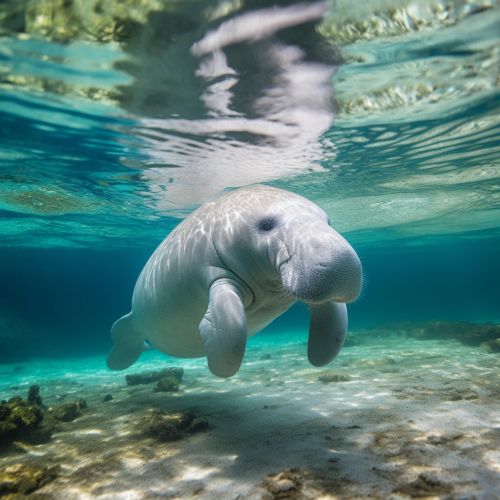Dugong
Taxonomy and Evolution
The Dugong (Dugong dugon) is a large marine mammal which, along with the manatee, is one of four living species of the order Sirenia. The Sirenia are part of the lineage that also includes the Proboscidean (elephants), and the hyraxes. The Dugong and its relatives are thought to have evolved around 50-60 million years ago from a group of land-dwelling mammals of the Tethytheria lineage, which also included the ancestor of the elephants.


Description
The Dugong is a large creature, reaching lengths of up to 3 meters and weights of up to 400 kilograms. It has a streamlined body adapted for swift swimming and a paddle-like tail, similar to that of dolphins. Unlike its manatee relatives, the Dugong's teeth do not continually grow back via horizontal tooth replacement. Instead, the Dugong's molars are replaced by small rudimentary teeth which are often lost, leaving the Dugong with only the original molars it had as a juvenile.
Distribution and Habitat
Dugongs inhabit the warm coastal waters from East Africa to Australia, including the Red Sea, Indian Ocean, and Pacific. They are typically found in shallow, protected areas such as seagrass meadows and mangrove channels. The Dugong's distribution is now highly fragmented, and the animal is extinct in many areas where it was once common.
Diet
The Dugong is primarily a herbivore, with a diet consisting almost entirely of seagrass. The animal uses its muscular upper lip to dig up entire plants, and then shakes them to remove the sand before eating. The Dugong's diet is highly specialized, and most of its nutritional needs can be met by eating a wide variety of seagrasses. However, the Dugong will occasionally eat small fish and invertebrates when seagrass is scarce.
Reproduction and Lifespan
Dugongs have a slow rate of reproduction, similar to that of humans. Females give birth to a single calf after a gestation period of about a year. The calf then remains with its mother for up to six years, until it is fully mature. Dugongs can live for up to 70 years, although many do not reach this age due to factors such as hunting and habitat loss.
Threats and Conservation
Dugongs are threatened by a variety of factors, including hunting, habitat loss, and boat strikes. In many parts of its range, the Dugong is hunted for its meat and oil. Habitat loss, particularly of seagrass meadows, is also a major threat. Conservation efforts for the Dugong include habitat protection, regulation of hunting, and the establishment of marine protected areas.
